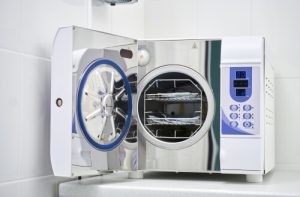In the realm of medical and laboratory equipment, ensuring sterilisation is paramount. Enter the leak rate test autoclave, a pivotal process that might sound intricate to the uninitiated. But why is this test so integral to the world of autoclaves, and what makes it a cornerstone of equipment reliability?
Journey with us as we unravel the mysteries behind the leak rate test autoclave, providing a glimpse into its significance while whetting your appetite for a detailed exploration.
Leak testing methods
 Ensuring the air-tight integrity of sterilisation chambers is paramount in medical and laboratory equipment. Leak tests, pivotal in this validation, stand at the intersection of patient safety, equipment reliability, and operational accuracy. Let’s deep dive into the various leak testing methods:
Ensuring the air-tight integrity of sterilisation chambers is paramount in medical and laboratory equipment. Leak tests, pivotal in this validation, stand at the intersection of patient safety, equipment reliability, and operational accuracy. Let’s deep dive into the various leak testing methods:
1. Vacuum Leak Test:
The vacuum leak test plays a crucial role at the forefront of leak testing methods. It ensures the autoclave chamber can maintain deep vacuum conditions without leaks.
Subjecting the steriliser chamber to vacuum conditions and observing how much vacuum depth it can sustain over a given period makes any potential breaches in the chamber’s integrity evident.
2. Bowie Dick Test:
The bowie dick test is a critical test tailored for pre-vacuum autoclaves. Using a bowie dick test pack, essentially a porous load placed inside an empty chamber, this test exposes the sterilisation chamber to a warm-up cycle, evaluating it for steam penetration and air removal. A failed bowie dick test pack could hint at issues within the autoclave’s plumbing system or control screen.
3. Pressure Test Leak Rate:
This method specifically measures the rate at which air or sterile air might enter a perfectly sealed chamber under pressure. It’s an invaluable tool for identifying even the minutest breaches, making it a good diagnostic tool for sterilisation.
4. Weekly Testing Regimen:
A weekly testing regimen is often recommended to ensure the proper operation of highly specialised equipment like autoclaves. This test cycle typically combines vacuum leak tests, bowie dick tests, and other standard operating procedures to assess the system comprehensively.
5. Biological Indicators:
While this test is not a leak test in the traditional sense, biological indicators offer insights into the efficacy of the steam sterilisation process. A failed indicator could indirectly hint at air leaks, compromised vacuum depth, or other issues with the autoclave’s plumbing, necessitating further diagnostic tests.
The sanctity of medical devices and the sterilisation process rests heavily on the shoulders of rigorous testing procedures. Leak tests, from the fundamental vacuum leak test to the more specialised bowie dick test, ensure that the equipment operates seamlessly, safeguarding both the equipment’s lifespan and, more crucially, patient safety. It’s a complex dance of air, pressure, and highly specialised equipment, where even the smallest misstep can have significant consequences. Hence, understanding and regularly employing these leak testing methods is imperative in medical sterilisation.
Pre-vacuum autoclave chamber
Central to the modern sterilisation process, the chamber of a pre-vacuum autoclave is a marvel of engineering designed to ensure optimal sterilisation of medical and laboratory instruments. Here’s a brief overview of its functionalities and significance:
- Air Removal: The primary function of a pre-vacuum autoclave’s chamber is efficiently removing air. Creating a vacuum ensures that steam can penetrate even the most intricate parts of instruments, guaranteeing thorough sterilisation.
- Steam Penetration: Once the air is evacuated, the chamber is filled with steam under pressure. This high-pressure steam environment is crucial for effectively eliminating microorganisms, including stubborn spores.
- Temperature Regulation: The chamber is calibrated to maintain a consistent temperature, usually around 121°C to 134°C, depending on the sterilisation protocol. This uniform temperature ensures all items within the chamber are sterilised uniformly.
- Safety Mechanisms: Equipped with advanced safety features, the chamber is designed to prevent accidents, such as over-pressurisation, ensuring both the safety of the equipment and the operator.
- Durability: Built from robust materials, typically stainless steel, the chamber is designed to withstand repeated cycles of high pressure and temperature, ensuring longevity and reliability.
In essence, the chamber of a pre-vacuum autoclave is the heart of the sterilisation process. Its design and functionalities ensure that medical and laboratory instruments are free from microorganisms and safe for subsequent use, playing a pivotal role in patient safety and the overall efficacy of medical procedures.
The importance of the autoclave’s control screen
In the intricate symphony of sterilisation, the autoclave’s control screen plays the pivotal role of a conductor. This seemingly simple interface, often laden with digital displays and buttons, is the central command guiding the entire operation of an autoclave. Let’s explore its undeniable significance:
- User Interface: At its core, the control screen is the primary interface between the operator and the machine. It provides real-time data, settings, and options, ensuring a seamless interaction for the user.
- Monitoring Capabilities: The control screen continuously displays vital parameters like temperature, pressure, and cycle duration. This real-time feedback allows for immediate adjustments, ensuring optimal sterilisation conditions are maintained.
- Program Customisation: Modern autoclaves have various sterilisation cycles suited for different materials. The control screen lets operators select and customise these cycles based on specific requirements.
- Safety Alerts: In the event of anomalies or malfunctions, the control screen provides critical alerts. Whether it’s a door seal issue, over-temperature, or pressure irregularities, timely alerts ensure operator safety and equipment protection.
- Historical Data & Record Keeping: Many advanced control screens store historical data, giving insights into past cycles, which can be invaluable for quality assurance and compliance.
In essence, the autoclave’s control screen is more than just a display; it’s the nerve centre of the sterilisation process. It underscores the importance of user-friendly design and technological integration in modern medical equipment by facilitating communication, ensuring precision, and enhancing safety.
What is the weekly testing regimen?
 Within the meticulous confines of dental practice, ensuring the sterility of instruments is paramount for patient safety and care. A dental autoclave, pivotal in achieving this sterility, is subject to a rigorous weekly testing regimen designed to guarantee its efficacy and reliability. Here’s a snapshot of this essential protocol:
Within the meticulous confines of dental practice, ensuring the sterility of instruments is paramount for patient safety and care. A dental autoclave, pivotal in achieving this sterility, is subject to a rigorous weekly testing regimen designed to guarantee its efficacy and reliability. Here’s a snapshot of this essential protocol:
- Bowie-Dick Test: Conducted to verify the removal of air and the penetration of steam within the autoclave. This test ensures that even the most intricate of instruments are adequately sterilised.
- Vacuum Leak Test: Essential for pre-vacuum autoclaves, this test ascertains the chamber’s integrity, ensuring there are no leaks that could compromise the sterilisation process.
- Biological Indicators: These are microorganism-based tests which are introduced and then retrieved from the autoclave to confirm the complete eradication of bacterial spores, offering a high assurance level of effective sterilisation.
- Chemical Indicators: Typically in the form of tapes, strips, or challenge packs, they change colour when exposed to the conditions within the autoclave, serving as a quick visual confirmation of the achieved conditions.
- Temperature and Pressure Monitoring: Regular checks on the autoclave’s temperature and pressure metrics are essential to ensure that it operates within the stipulated ranges, crucial for effective sterilisation.
- Review and Documentation: Each test’s results are meticulously documented, offering a record for compliance, quality assurance, and a basis for any required troubleshooting.
In sum, the weekly testing regimen for dental autoclaves is a testament to the dental industry’s commitment to patient safety and care excellence. By ensuring that every instrument is free of microbial life, dental professionals safeguard not just the health but also the trust of their patients.
Conclusion
The importance of sterilisation in medical settings cannot be emphasised enough. Ensuring the reliability and efficiency of equipment like autoclaves is a cornerstone of patient safety and procedural accuracy. The leak rate test autoclave stands as a testament to the commitment of the medical community to uphold the highest standards. As technology advances and protocols become even more stringent, the role of tests like these will only continue to grow in importance, safeguarding health and ensuring the trustworthiness of equipment. Stay informed and ensure your autoclave undergoes regular leak rate testing for optimal performance.
In wrapping up our exploration on the Leak Rate Test Autoclave, it’s clear that maintaining the integrity of your sterilisation equipment is paramount. Should you have any queries or need expert assistance on this front, don’t hesitate. Reach out to our specialists at MELAG AUTOCLAVE on (02) 8880 7813. Your confidence in sterilisation processes is just a call away. Secure your peace of mind and make the call today!
References
A simple method of locating air leakage points in prevacuum autoclaves failing the Bowie-Dick test
https://www.researchgate.net/publication/289471270_A_simple_method_of_locating_air_leakage_points_in_prevacuum_autoclaves_failing_the_Bowie-Dick_test
A comparative study of four Bowie-Dick test under the condition of pressure steam sterilizer simulating gas leakage
https://www.ncbi.nlm.nih.gov/pmc/articles/PMC7738145/
BeliMed Autoclave manual
https://www.lebonheur.org/research/investigator-resources/manuals/BeliMed%20Autoclave%20manual.pdf
Steam generator tube integrity program leak rate tests. Progress report
https://www.osti.gov/servlets/purl/5388200


